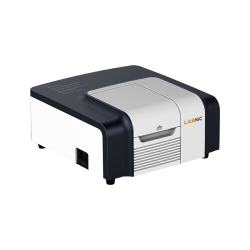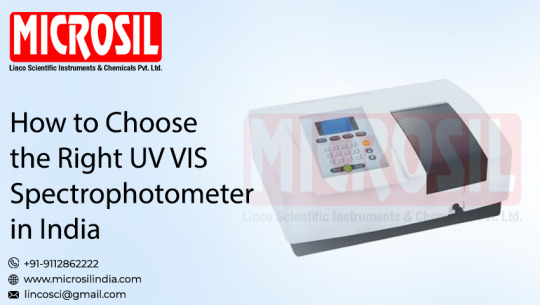#uv spectrophotometer
Explore tagged Tumblr posts
Text
Exhibitions Certificate — Lasany International
Feeling proud and honored to receive this Certificate of Participation for our exhibit at Asia Labex and Asima and Global Lab. Our team put in so much effort and it's amazing to see it recognized. A big thank you to Lasany International for supporting us and believing in our work.
For More Information Call Us:- 9803047917



#uv spectrophotometer#uv visible spectrophotometer#laboratory equipments#chemistry lab equipment#science lab equipment
1 note
·
View note
Text
Exploring the Role of UV VIS Spectrophotometer in Modern Science

A UV Vis spectrophotometer measures the absorbance or transmittance of ultraviolet and visible light by a sample, providing insights into its composition and concentration. Commonly used in chemistry, biology, and material sciences, it enables precise analysis of molecules with chromophores. Applications include protein quantification, DNA analysis, and quality control in industries like pharmaceuticals and environmental monitoring. Microsil India, a trusted UV Vis spectrophotometer manufacturer, delivers precise, high-quality instruments for advanced research, industrial analysis, and academic applications, ensuring accuracy and reliability every time.
0 notes
Text

Double-beam UV-Visible Spectrophotometer
Double-beam UV-Visible Spectrophotometer is adopted with microcomputer technology and electronic control system, features holographic grating with 1200 lines/mm. Equipped with solid silicone photodiode detector and xenon lamp as light source, have 190 to 1100 nm of wavelength range. Designed with 7-inch TFT screen with sensitive buttons and large sample chamber, it also supports USB storage and different data formats.
#Double-beam UV-Visible Spectrophotometer manufacturerMeterin Georgia#Double-beam UV-Visible Spectrophotometer suppliers in Georgia#Double-beam UV-Visible Spectrophotometer manufacturer in Hawaii#Double-beam UV-Visible Spectrophotometer suppliers in Hawaii#Double-beam UV-Visible Spectrophotometer manufacturer in Indiana#Double-beam UV-Visible Spectrophotometer suppliers in Indiana#Double-beam UV-Visible Spectrophotometer manufacturer in Iowa#Double-beam UV-Visible Spectrophotometer suppliers in Iowa
0 notes
Text

Atomic absorption spectrophotometer comes with Deuterium lamp for background correction, RS232 interface, Multi-linear and nonlinear curve fitting. Its double beam system automatically compensates the light source drift andw avelength drift caused by the variation of temperature and electronic circuit drift so as to reach a good basic line stability. The specially designed fine light beam passes through the flame to ensure a high precision analytical test and low characteristic concentration in this atomic absorption spectrophotometer. It has multiple applications in research and development and industrial analysis.
0 notes
Text
Visible Spectrophotometer

A visible spectrophotometer is a laboratory instrument used to measure the intensity of light absorption or transmission of a sample in the visible region of the electromagnetic spectrum. It's a crucial tool in various scientific disciplines such as chemistry, biochemistry, biology, physics, and environmental science.
1 note
·
View note
Text
Leading UV-Vis Spectrophotometer Xenon Lamp Manufacturer
Uncover brilliance in every wavelength with our Xenon Lamp-powered UV-Vis Spectrophotometers. Precision analysis for scientific excellence! We are leading UV-Vis Spectrophotometer Xenon Lamp Manufacturer, supplier and exporter from India. For product details or quotes contact us via email and chat support.

#UV-Vis Spectrophotometer with Xenon Lamp Manufacturer#UV-Vis Spectrophotometer with Xenon Lamp Supplier#UV-Vis Spectrophotometer with Xenon Lamp Exporter#UV-Vis Spectrophotometer with Xenon Lamp
0 notes
Text

UV-Visible Spectrophotometer
UV-Visible Spectrophotometer is a double beam instrument with a computer simulation optimized optical base. The continuously adjustable spectral bandwidth ranges from 0.1 to 5nm, making it ideal for samples with sharp absorption peaks. Precision is improved across the UV-Vis spectrum, from 190nm to 900nm, due to the well-aligned PMT detector and high-quality deuterium, tungsten, and mercury lamps. The device includes an optional 8-position cell holder as well as a high throughput 100-position autosampler with an easy-to-use interface.
0 notes
Text
Single Beam UV/Vis Spectrophotometer

Wavelength range=190-to-1100-nm; Spectral bandwidth=2-nm; Wavelength Accuracy=plusmn-0-1nm-656-1-nm-plusmn-0-3-nm-all; Wavelength Repeatability=le-0-1-nm; Optical system=single-beam-1200-lines-mm. Shop Online at Labtron.us
0 notes
Text

UV-VIS Spectrophotometers
UV-VIS Spectrophotometers are Equipped with a microprocessor to set parameters and a 1200-line double beam grating, which ensures high resolution. For more, visit www.Labozon.com.
0 notes
Note
Oh my god, I absolutely ADORE lab equipment. There's just something to dreamy about those little machines and it pains me so much that they're either expensive or impossible to get. My most recent crush has definitely been the Pharmacia LKB Ultrospec Plus UV-Vis Spectrophotometer, specifically one I saw in a tiktok that always gets the date wrong but they cost like 200 bucks and there are like 5 pictures of them online.
Sorry for the ramble, I'm just always happy to see fellow lab equipment enthusiasts <3
I LOVE THIS ASK, I absolutely adore lab equipment. there's a dearth of people talking about it, I should post some more... I've had the fortune to use some of the big biochem machines before and they are an absolute delight -- including the miniature sibling of that one I just reblogged, the NOVA FLEX2:

22 notes
·
View notes
Note
The niche attraction post is so real because I am attracted to the Pharmacia LKB Ultrospec Plus UV-Vis Spectrophotometer (I know, a mouthful) and it is such a specific model of such a specific object there are like 5 pictures of it online and they cost like 200 bucks😭
Anyway, if I ever get my hands on one, I'm gonna romance the hell out of it and until then, I'll continue to dreamily look at the same 3 listings of it
tumblr didn't notify me of this 🥹
looked it up and i definitely get where you're coming from, they're so shaped ☺️ i hope you get your hands on one someday!!
4 notes
·
View notes
Text

Visible Spectrophotometer Model – LI – 721s | Lasany International
Visible Spectrophotometer Model LI-721s by Lasany International is a precision instrument designed for accurate measurement of light absorbance in the visible spectrum. It features user-friendly controls and high reliability for various laboratory applications. This model ensures precise, consistent results suitable for research and quality control purposes.
#science lab equipment#spectrophotometer supplier in brazil#blood collection monitor#digital rotational viscometer suppliers in india#double beam uv vis spectrophotometer#electronic plasma expressor#digital viscometer manufacturer in india#digital viscometer#flame atomic absorption spectroscopy#blood bag tube sealer manufacturers#Automatic Seed Counter#Hpcl Supplier#Hplc Manufacturer#Spectrophotometer Suppliers#Digital Viscometer#Spectrometer Manufacturers In India#Tube Sealer Supplier In Syria#Blood Collection Monitors In Peru#Hplc Manufacturer In India#Digital Rotational Viscometer Suppliers In Iran#Fluorescence Spectrophotometers In Syrian#Spectrophotometer Suppliers In Kenya#Best Automatic Seed Counter Supplier In Kenya#Hpcl Supplier In Zimbabwe#Fluorescence Spectrophotometer#Atomic Absorption Spectrophotometer#Uv-vis Spectrophotometer#Science Lab Equipment#Flame Atomic Absorption Spectroscopy#Blood Collection Monitor
0 notes
Text
How to Choose the Right UV VIS Spectrophotometer in India

A UV-Vis spectrophotometer measures the absorbance and transmittance of light in the ultraviolet and visible regions of the electromagnetic spectrum. It is widely used in chemistry, biology, and materials science for analyzing the concentration of solutions, studying reaction kinetics, and characterizing compounds. Microsil India: Leading UV-Vis spectrophotometer manufacturer in India, delivering precision, reliability, and innovation for accurate scientific and industrial applications. The instrument provides vital data for qualitative and quantitative analysis in various research fields.
#UV-Vis spectrophotometer#UV-Vis spectrophotometer manufacturer#UV-Vis spectrophotometer manufacturer in India#Top UV-Vis spectrophotometer manufacturer in India#Best UV-Vis spectrophotometer manufacturer in India
0 notes
Text

Double Beam UV-Visible Spectrophotometer
Double Beam UV-Visible Spectrophotometer is a compact, tabletop, double beam and Czerny-Turner monochromator comprised Double Beam UV-Visible Spectrophotometer, comes with 20 mm of focal length and 1600 lines/mm of grating. With 190 to 1100 nm of wavelength range, features adjustable 5-speed bandwidth of 0.5 nm, 1 nm, 2 nm, 4 nm, and 5 nm with fast-medium-slow scanning speed. Designed with Silicon Photocell detector, deuterium and tungsten lamp as light source, and 8-inch color touch-screen, supports spectra printing, storage and data analysis. Incorporated with USB communication port, ARM chip control and data processing, and easy user interface, this spectrophotometer has automatic scanning of measured spectrum, multi-wavelength (1-3 λ) measurement, kinetic measurement, 1-3 curve fitting, and 1-4 derivative spectra.
#Double Beam UV-Visible Spectrophotometer manufacturer in Virginia#Double Beam UV-Visible Spectrophotometer suppliers in Virginia#Double Beam UV-Visible Spectrophotometer manufacturer in Washington#Double Beam UV-Visible Spectrophotometer suppliers in Washington#Double Beam UV-Visible Spectrophotometer manufacturer in Wyoming#Double Beam UV-Visible Spectrophotometer suppliers in Wyoming
0 notes
Link
1 note
·
View note
Text
UV-Visible Spectrophotometer

A UV-Visible spectrophotometer is a scientific instrument used to measure the absorption of light in the ultraviolet (UV) and visible (VIS) regions of the electromagnetic spectrum. It's widely used in various fields such as chemistry, biochemistry, molecular biology, environmental science, pharmaceuticals, and materials science.
0 notes